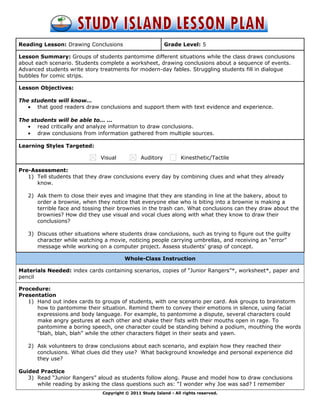More Related Content
Similar to 5 lp drawing_conclusions
Similar to 5 lp drawing_conclusions (20)
5 lp drawing_conclusions
- 1. Reading Lesson: Drawing Conclusions Grade Level: 5
Lesson Summary: Groups of students pantomime different situations while the class draws conclusions
about each scenario. Students complete a worksheet, drawing conclusions about a sequence of events.
Advanced students write story treatments for modern-day fables. Struggling students fill in dialogue
bubbles for comic strips.
Lesson Objectives:
The students will know…
· that good readers draw conclusions and support them with text evidence and experience.
The students will be able to… …
· read critically and analyze information to draw conclusions.
· draw conclusions from information gathered from multiple sources.
Learning Styles Targeted:
Visual Auditory Kinesthetic/Tactile
Pre-Assessment:
1) Tell students that they draw conclusions every day by combining clues and what they already
know.
2) Ask them to close their eyes and imagine that they are standing in line at the bakery, about to
order a brownie, when they notice that everyone else who is biting into a brownie is making a
terrible face and tossing their brownies in the trash can. What conclusions can they draw about the
brownies? How did they use visual and vocal clues along with what they know to draw their
conclusions?
3) Discuss other situations where students draw conclusions, such as trying to figure out the guilty
character while watching a movie, noticing people carrying umbrellas, and receiving an “error”
message while working on a computer project. Assess students’ grasp of concept.
Whole-Class Instruction
Materials Needed: index cards containing scenarios, copies of “Junior Rangers”*, worksheet*, paper and
pencil
Procedure:
Presentation
1) Hand out index cards to groups of students, with one scenario per card. Ask groups to brainstorm
how to pantomime their situation. Remind them to convey their emotions in silence, using facial
expressions and body language. For example, to pantomime a dispute, several characters could
make angry gestures at each other and shake their fists with their mouths open in rage. To
pantomime a boring speech, one character could be standing behind a podium, mouthing the words
“blah, blah, blah” while the other characters fidget in their seats and yawn.
2) Ask volunteers to draw conclusions about each scenario, and explain how they reached their
conclusions. What clues did they use? What background knowledge and personal experience did
they use?
Guided Practice
3) Read “Junior Rangers” aloud as students follow along. Pause and model how to draw conclusions
while reading by asking the class questions such as: “I wonder why Joe was sad? I remember
Copyright © 2011 Study Island - All rights reserved.
- 2. something similar happened to me, and I was also sad.”
4) Ask students what conclusions they can draw about Joe. Encourage students to make a connection
between the story and similar real-life experiences or similar characters they have encountered.
Independent Practice
5) Have students complete the worksheet, selecting an answer that best matches 10 scenarios.
Closing Activity
6) Ask students to write a sentence about how they draw conclusions while reading a mystery or
watching a suspenseful movie.
Advanced Learner
Materials Needed: “Aesop’s Fables,” paper, pencil
Procedure:
1) Ask students to read one of the Aesop’s fables (either from the library or downloaded from the
Internet) and draw conclusions about the character or the event in the fable.
2) Have students develop the plot for a modern-day fable that draws a conclusion. Tell them to write a
one-paragraph story treatment as if they were pitching a screenplay to a movie producer. Students
can share their pitches with the class.
Struggling Learner
Materials Needed: copies of comic strip with dialogue bubbles deleted, pencils
Procedure:
1) Remind students that they use story details, prior knowledge, and logical thinking to draw
conclusions about characters and story events while reading a variety of genres, including comic
strips.
2) Show students the comic strip and model how to insert dialogue bubbles. Then have students
consider what the characters are doing, and use this graphic evidence to draw conclusions about
the plotline. Students should fill in the bubbles with thoughts and/or dialogue.
3) Bind the comics together into a classroom booklet.
*see supplemental resources
Copyright © 2011 Study Island - All rights reserved.
